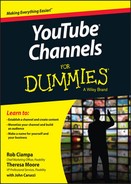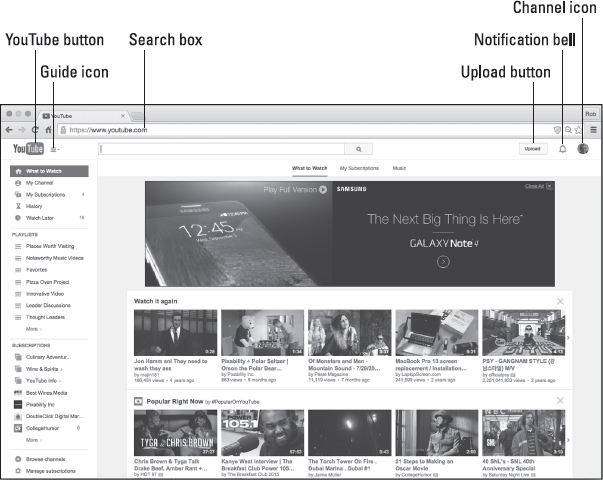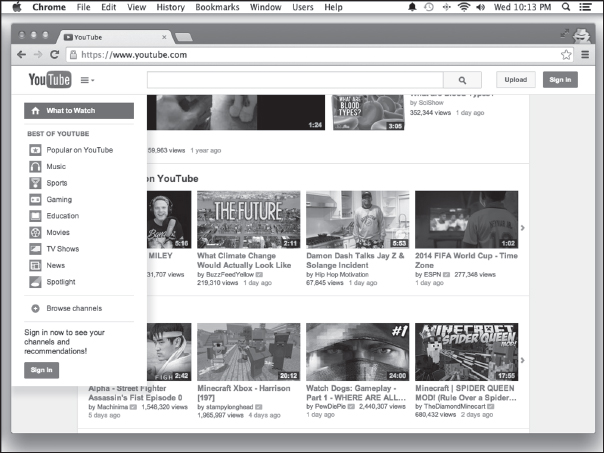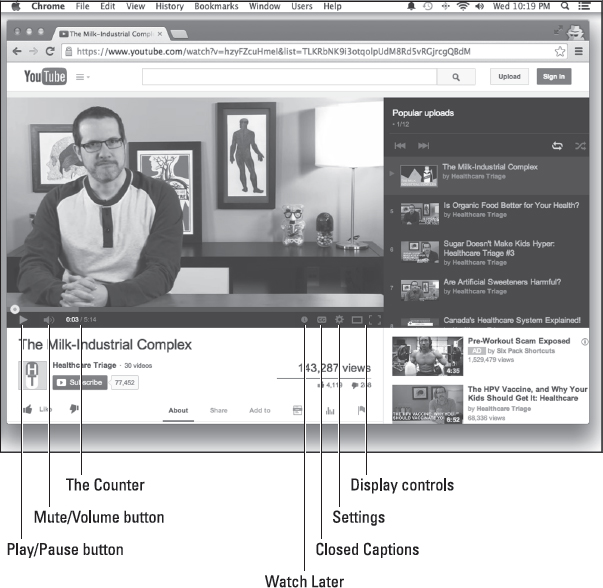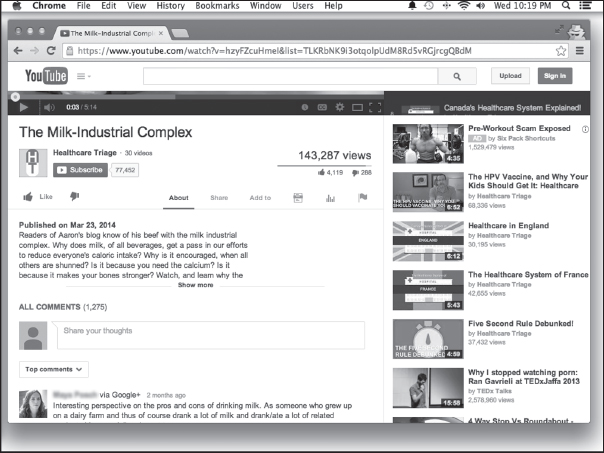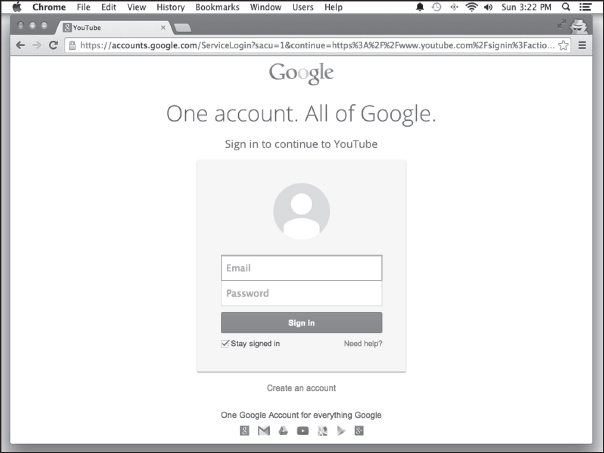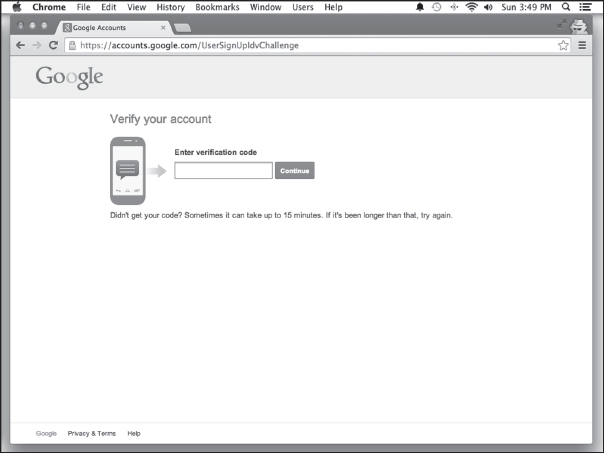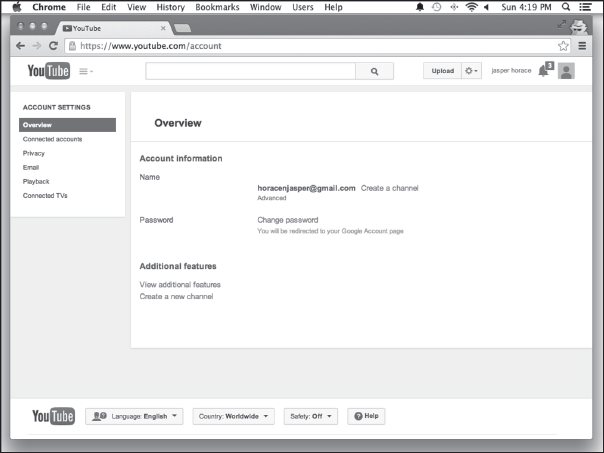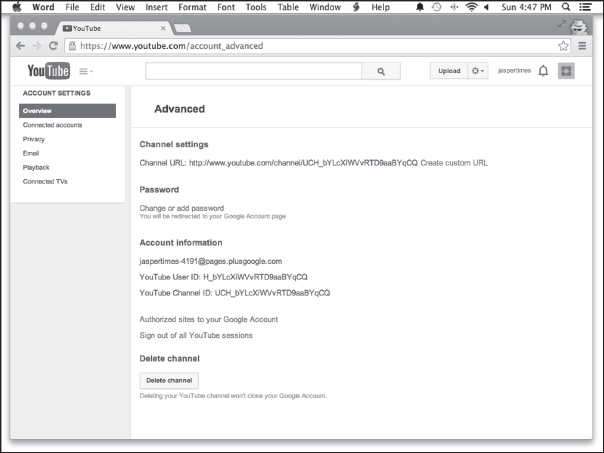Chapter 2
The Basics of YouTube
In This Chapter
- Navigating the basics of the YouTube interface
- Watching YouTube videos
- Creating a YouTube account
- Setting up a unique channel URL
- Checking out the YouTube Partner Program
In the simplest sense, YouTube is a website designed for sharing video. Before YouTube's founding in 2005, posting and sharing a video online was difficult: The bandwidth and storage needed to stream video were expensive, and many copyright risks were involved in letting people upload whatever they wanted. Because YouTube was willing to absorb the costs and ignore the risks, it provided the infrastructure for users to upload and view as much video as they wanted, for free. This proposition turned out to be a popular one.
Google acquired YouTube in 2006, and YouTube's growth continued. As of 2014, users watch more than 6 billion hours of video per month, and more than 300 hours of video are uploaded every minute.
Let us say that last part again: 300 hours of video are uploaded to YouTube every minute.
Given that amount of content, you, as an individual, could never watch everything that's available on YouTube. For every minute of video you watch, you're 300 hours behind. For every work of genius, such as “Cat in a Shark Costume Chases a Duck While Riding a Roomba,” YouTube has literally tens of thousands of poorly shot, poorly edited videos of family vacations, dance recitals, and bad jokes that could possibly be of interest only to the uploader. This chapter serves as your (essential) guide to finding the good parts while skipping the bad. (Hey, it's a tough job, but somebody had to do it, and that somebody was us.) We help you navigate the YouTube interface, establish an account, and start looking ahead to planning a channel. If you're new to YouTube or you need to dig a bit deeper as a user, this is the chapter for you.
What You'll Find on YouTube
You'll find, in a word, videos on YouTube. You'll find, in several words, just about anything on YouTube. We would say that you'll find anything you can imagine, but even we never would have imagined that anyone would make a 10-hour loop of the Nyan Cat meme video, and we definitely wouldn't have imagined that it would have been viewed over 39 million times. The best way to describe what's on YouTube may be to start with the categories YouTube lists on its home page.
Managing your identity
Your entire YouTube experience is driven by whether YouTube knows who you are. It doesn't use any magic to figure that out. Instead, YouTube simply determines whether you're logged in or logged out. When you log in, YouTube can make video recommendations based on your viewing behavior. In other words, after YouTube knows what you like, it does its best to bring more of that great video content to you.
 YouTube and its parent Google are in the advertising business and are not promoting online video for the betterment of mankind. (Though some channels on YouTube actually help achieve that goal.) By understanding your viewing behavior when you're logged in, YouTube and Google are able to serve better and more relevant ads to you. That's good for them, for the advertiser, and for the viewer. Sure, most people don't like ads, but YouTube is truly trying to do a better job of targeting ads. (Chapter 13 covers this topic in more detail.)
YouTube and its parent Google are in the advertising business and are not promoting online video for the betterment of mankind. (Though some channels on YouTube actually help achieve that goal.) By understanding your viewing behavior when you're logged in, YouTube and Google are able to serve better and more relevant ads to you. That's good for them, for the advertiser, and for the viewer. Sure, most people don't like ads, but YouTube is truly trying to do a better job of targeting ads. (Chapter 13 covers this topic in more detail.)
As you can see in this chapter and throughout the book, you need to be logged in to do most of the important things on YouTube. Sure, you can watch videos without being logged in, but you'll miss a good part of the experience. You need a Google account to log in, and we show you how to set up one of those a little later in this chapter. You also have the option of creating a YouTube channel that goes with your Google account.
 You don't need a YouTube channel to log in to YouTube, just a Google account. Having a channel though, as you'll soon find out, will help you organize your YouTube viewing without having to create any videos.
You don't need a YouTube channel to log in to YouTube, just a Google account. Having a channel though, as you'll soon find out, will help you organize your YouTube viewing without having to create any videos.
Navigating the home page
The home page of YouTube (www.youtube.com) is a fickle beast. It was once the fount of discovery for YouTube users. If you were looking for new content, the home page was the place to be. Over the years, though, YouTube changed the home page experience. Many changes have been tied to the company's desire to know its users. Users who are logged in with accounts and who have a history of using YouTube see videos that might appeal to them based on past usage. New users and those not logged in see the things that are currently most popular on the site.
The logged-in experience
As long as you're logged in to YouTube when you watch videos, the site is busily keeping track of everything you see and trying to form an idea about what kind of videos you like. This information dynamically drives the home page you see, and YouTube tries to show you videos that it thinks you'll like. Your home page will come to be dominated by material that is similar to material you've watched in the past.
Here's a quick tour of what you're likely to see when you log on to www.youtube.com after you create an account. (Again, we tell you more about creating an account later in this chapter.) Take a look at Figure 2-1 to see how a YouTube home page looks when you log in, and then read the descriptions in the following list:
Along the top
- The YouTube button: Though it looks exactly like the YouTube logo, this button actually does something in addition to looking pretty; clicking it always brings you back to the YouTube home page.
- The Guide icon: This button, consisting of three horizontal bars with a small down arrow, sits next to the YouTube button. Clicking it brings up a guide of channels and topics that may be of interest to the viewer.
- The Search box: This is where you search for videos. Enter keywords to find videos that may match what you're looking for.
- The Upload button: When you're ready to upload a video, you get started by using this button. (Read more about the Upload button in Chapter 9.)
- The Notifications bell: As a YouTube channel manager, you can be notified when activity happens on your channel, including comments, video sharing, and more.
- Channel icon: A round image button shows either the channel icon you come up with or an image associated with your Google ID when you're logged in. Use this to get to Creator Studio, which is your YouTube “mission control center,” or to configure your YouTube account settings. You'll learn about both of those features in Chapter 3.
 You can log into YouTube through your Google account, but we recommend having an associated YouTube channel to get all the benefits of your YouTube experience, such as creating playlists. (For more on playlists, see Chapter 3.)
You can log into YouTube through your Google account, but we recommend having an associated YouTube channel to get all the benefits of your YouTube experience, such as creating playlists. (For more on playlists, see Chapter 3.)Down the left side
 The menu functions running down the left side of the screen complement the functionality of the ones that run across the top and focus more on content. You can toggle what's shown on the left side by clicking the Guide icon.
The menu functions running down the left side of the screen complement the functionality of the ones that run across the top and focus more on content. You can toggle what's shown on the left side by clicking the Guide icon. - What to Watch: This option is selected by default when you arrive at the YouTube home page. When this section is selected, the main window of the site shows you lists of channels and videos that YouTube assumes you'll like:
- My Channel: Clicking this link brings up the home page of your YouTube channel and shows you how other viewers see it. My Channel includes channel art, video trailers, sections, and channels you recommend. To handle all the behind-the-scenes management, you use Creator Studio, which you learn about in Chapter 3.
- My Subscriptions: This is where you manage the channels you're subscribed to. Subscriptions are a good way to keep track of the channels you like on YouTube, but the subscription model has changed a lot in the past couple of years. We talk about subscriptions in detail in Chapter 10.
- History: Click here to review your YouTube history, which can be extensive. You can track which channels you've visited and which videos you've watched, and even see your comment history, all in one place.
 You'll end up seeing a lot of videos on YouTube and there's going to be a point where you'll want to go back to see what you've viewed or to watch a particular video again. The History section is a great way to keep track of what you've watched and analyze your viewing.
You'll end up seeing a lot of videos on YouTube and there's going to be a point where you'll want to go back to see what you've viewed or to watch a particular video again. The History section is a great way to keep track of what you've watched and analyze your viewing. - Watch Later: This link leads to a list of videos you've flagged for later viewing using the creatively named Watch Later button in the YouTube player window.
- Playlists: Playlists are a great way to organize videos you've discovered on YouTube. This section highlights some of your playlists and has a clickable link to your Playlist Management page. There, you can create and edit playlists for your own consumption, or you can use them to organize the videos on your channel, as discussed in detail in Chapter 3.
- Subscriptions: This section highlights some of your subscriptions and has a clickable link to your Subscription Management page. You learned earlier that subscriptions are a good way to keep track of the channels you like on YouTube.
- Browse Channels: This link takes you to a page where YouTube makes suggestions of channels that may interest you based on your prior viewing habits. It recommends channels in many of the categories we look into in the “Logged-out experience”, later in this chapter.
- Manage Subscriptions: Click to go to the Subscription Management page, where you can control how your subscriptions are organized and how you're notified about activity on the channels to which you subscribe.

 You've now seen more than a few references to subscriptions in the Guide. Subscriptions and subscription management are a big deal on YouTube because they serve to support a strong connection between a viewer and a channel.
You've now seen more than a few references to subscriptions in the Guide. Subscriptions and subscription management are a big deal on YouTube because they serve to support a strong connection between a viewer and a channel.
Advertisement
 Banner ad: Last but not least, the largest element on the YouTube landing page is a banner ad — sometimes with and sometimes without its own, embedded video. The ad is probably not what you came to YouTube to see, but ad revenue keeps the lights on and the video flowing.
Banner ad: Last but not least, the largest element on the YouTube landing page is a banner ad — sometimes with and sometimes without its own, embedded video. The ad is probably not what you came to YouTube to see, but ad revenue keeps the lights on and the video flowing.
 If you'd rather not look at the big banner ad, you can usually close the ad by clicking the Close Ad button in one of the banner's corners.
If you'd rather not look at the big banner ad, you can usually close the ad by clicking the Close Ad button in one of the banner's corners.
The logged-out experience
When you arrive at YouTube before you've taken the trouble to create an account, you see the pure, innocent YouTube of the viewer with no viewing history. Treasure this moment, this innocence, this pure instant of seeing the site as it is. You'll soon be a jaded viewer, with a viewing history filled with reminders of the hours spent watching One Direction videos. Have a look at Figure 2-2 to see what YouTube looks like to the user who is logged out.
Why does YouTube have ads?
It's always flattering when people listen to you and seem to be interested in knowing exactly who you are. You might think that YouTube is a great listener, just because it takes a great interest in the kinds of videos you're watching, but that's not because YouTube has suddenly decided that you two are going to be Best Friends Forever. The truth is that YouTube's product — the way it makes money — is not streaming video. In fact, the streaming video part costs the company quite a bit of money because it's expensive for it to host the GoPro videos you made of your dog's bath.
So if YouTube isn't making money hosting and serving videos, how is it making money? Here's the dirty secret: It's making money selling advertisements! That means you are YouTube's product. It's selling your attention to advertisers, and that's why YouTube wants so badly to know you. It wants to be able to tell its ad-buying customers exactly who is watching their ads.
Though all this information may seem to be much like a dystopian police state, it turns out that it's something that can work in your favor when you launch a channel with an eye toward making money from your content. We get to the details on grabbing your share of YouTube ad revenue in Chapter 14.
Figure 2-2: The logged-out YouTube home page.
On the left side of the screen, you see a list of links to the Best of YouTube channels. These verticals, as they're called, are the primary content divisions on YouTube. Verticals are sort of like the sections of a newspaper. Like a newspaper, YouTube is organized into sections so that you can find the type of content you want to watch. You can subscribe to any of these verticals like it's a normal user channel.
 The programming on YouTube is divided into verticals. (Anywhere else, these content divisions would be called genres.) Verticals are all a combination of YouTube native content (content produced by regular YouTube users) and content produced by traditional media companies like CNN and The Onion. One amazing aspect of YouTube is that individuals can still manage to have a voice just as loud as the major media players (which is one fundamental point of this book).
The programming on YouTube is divided into verticals. (Anywhere else, these content divisions would be called genres.) Verticals are all a combination of YouTube native content (content produced by regular YouTube users) and content produced by traditional media companies like CNN and The Onion. One amazing aspect of YouTube is that individuals can still manage to have a voice just as loud as the major media players (which is one fundamental point of this book).
It's time to see what the verticals have to offer:
- Popular on YouTube: This one is very much what it sounds like — a channel filled with what's currently popular now on YouTube across diverse categories, from news to music videos and everywhere in-between. It's also a great way to keep up with what's hot in contemporary culture.
- Music: Music is a big deal on YouTube. Twenty-two of the 100 most-subscribed channels are music channels. Though MTV once showed music videos, that niche is now filled by YouTube, and much of that traffic is dominated by VEVO, which offers music videos from big-name entertainment conglomerates such as Universal Music Group and Sony Music Entertainment.
- Sports: Sports videos are also extremely popular on YouTube. The Sports vertical is an interesting blend of mainstream sports video from sources like ESPN, the NFL, and other major sports leagues, to parkour and extreme sports videos shot with the extremely popular GoPro camera line.
- Gaming: This vertical is one of the most mysterious. It has, of course, the content you'd expect, including promotional videos from game publishers, reviews and news from established video game voices like IGN, reviews from YouTube users, and content from some of the largest multi-channel networks, such as Machinima. (You'll learn more about multi-channel networks, also known as MCNs, in Bonus Chapter 2.) The Gaming vertical is also the home of the Let's Play genre, one of the most popular on YouTube. Creators such as PewDiePie and Sky Does Minecraft garner millions of viewers posting videos of themselves playing popular video games and commenting on the gameplay as they play. These videos are hugely popular, and Minecraft demonstrations especially have a huge audience of young people on YouTube.
- Education: In the Education vertical, you'll find a wide range of educational videos. Universities and education foundations are very active, but it also has many YouTube natives, like the Khan Academy, CGP Grey, Minute Physics, Crash Course, and SciShow. Language learning is another immensely popular subsection of the Education vertical.
- Movies: This one is home to YouTube's movie rental business. You can rent Hollywood releases for streaming here, but we've never heard of anyone doing that. Some free movies are available and are worth checking out.
- TV Shows: In the TV Shows section, viewers can rent — you guessed it — streaming television shows.
- News: The News vertical consists of channels that cover a wide range of beats, including national news, world news, science, sports, entertainment, and so on.
- Live: You can catch live events from gaming to music to sports and much more.
- Spotlight: This is somewhat different from “Popular on YouTube” in that it itemizes what's new and emerging. Because it covers a collection of topics, you may find yourself spending more time in this section than you originally planned.
- Browse channels: Consists of a summary look at channels across different categories and interest groups.
 You can get a look at the home page without all the baggage of your past video views at any time. That way, you'll be sure to see (unfiltered) what's trending on the site. Just put your browser in a private browsing mode, such as Chrome's incognito browsing, and you'll see the YouTube home page with new eyes. You'll see which videos are hot on the site without any of the context of your past browsing.
You can get a look at the home page without all the baggage of your past video views at any time. That way, you'll be sure to see (unfiltered) what's trending on the site. Just put your browser in a private browsing mode, such as Chrome's incognito browsing, and you'll see the YouTube home page with new eyes. You'll see which videos are hot on the site without any of the context of your past browsing.
 In Apple's Safari browser and Mozilla Firefox, incognito browsing is called private browsing. In Internet Explorer, it's called InPrivate browsing.
In Apple's Safari browser and Mozilla Firefox, incognito browsing is called private browsing. In Internet Explorer, it's called InPrivate browsing.
Watching a video
The reason that most people visit YouTube is to watch videos. That should probably be one of the first things you do when you arrive. After familiarizing yourself with the home page, try clicking on a video. You're taken to a Watch page, which should look a lot like the one shown in Figure 2-3.
The Watch page is, first and foremost, for viewing videos, but it has a number of other functions as well. You'll want to be familiar with a number of elements on this page:
- Video Player: Front and center is the video player, which you'll use to watch the video.
- Video Info: Tucked beneath the video player you'll see the video info, including the video's title, view count, and a description field with information about the video.
- Comments: Everybody has an opinion, right? What's true about the world outside is equally true in the world of YouTube. Here's where viewers can comment on and discuss the video, and where the uploader occasionally joins in the discussion.
- Suggestions: Along the right side of the screen are the suggested videos, which are YouTube's best guesses about what you might want to watch next, based on the video you're watching and your overall watch history.
That's the birds-eye view. The next few sections take a closer look at some of these features in a bit more detail.
 The YouTube algorithm, the mysterious piece of code that is responsible for guessing what you want to watch next, is uncannily effective a lot of the time. The suggested videos have the ability to suck you into what is known as the YouTube spiral, in which you can potentially lose hours of your life clicking on video after video and eventually end up watching infomercials from the mid-1980s with no clear idea how you got there.
The YouTube algorithm, the mysterious piece of code that is responsible for guessing what you want to watch next, is uncannily effective a lot of the time. The suggested videos have the ability to suck you into what is known as the YouTube spiral, in which you can potentially lose hours of your life clicking on video after video and eventually end up watching infomercials from the mid-1980s with no clear idea how you got there.
The player
The most noticeable item on the Watch page is the video player. As with most video players, the YouTube version has a number of controls ranging along the along the bottom. Here's an overview of what each control does:
- The Scrubber: This bar runs the length of the video player and allows the viewer to jump around in the video. Click on the white circle and drag it to the right to “scrub” forward in the video.
- The Play/Pause button: This button stops and starts the video stream.
- The Mute/Volume control: When you roll over the speaker symbol, the Volume bar appears. Click the speaker to mute the audio. Use the volume slider to adjust the volume.
- The Counter: This is the timer for the video. It shows you how much viewing time has elapsed as well as the total length of the video.
- Watch Later: This button looks like a clock, and it simply adds the current video to the Watch Later playlist. The idea here is that, with this playlist keeping track of what you want to watch, you can easily wait for that perfect moment to watch the desired video(s).
- Closed Captions: This button, marked CC, toggles the captions. Not every video has good captions. (For more on captions — good, bad, and indifferent — check out Chapter 9.)
- Settings: You have to click the little Gear icon to access the Settings menu, but that's not too hard to do. For most videos, the available settings include toggling annotations on and off (we cover annotations in Chapter 10), changing the video speed, and setting the resolution of the video. We're big fans of watching the videos at normal speed and at the highest available resolution.
- Display Controls: You can change the size of the default player to show across the width of the browser (Theater mode) or take over the entire display (Full screen).
Most videos do not default to 1080p or 720p HD. The default playback is often 480p or lower, which doesn't look that great. If you want to watch videos in high definition, you have to become familiar with the Settings menu. Keep in mind that your Internet connection needs to be fast enough to stream HD video to avoid interruption.
The video info section
Directly below the video player, you'll find a bunch of information about the video that we usually call the video info. You can see a lot of data about each video there, as you can see in Figure 2-4.
Figure 2-4: The video info section.
Here's a list of the most important information to pay attention to in the video info:
- Title: In large type just below the video player is the title of the video. (We talk more about titles — more effective titles, to be specific — in Chapter 9. For now, think “catchy and relevant.”)
- Channel information: Just below the title you'll find the channel name and a logo known as the channel icon.
- Subscription status and control: In Chapter 10, you discover that subscriptions are important to channel managers and viewers because subscriptions provide a better level of engagement among the two. The Subscribe button, which is to the right of the channel icon, appears in red with a subscriber count number if the viewer is not subscribed. Simply clicking the button enables the subscription, and the button turns gray while adding a secondary subscription setting button that looks like a gear. Click this secondary button to control how you want to receive updates from the channel. To unsubscribe to a channel, all you need to do is click the gray Unsubscribed button.
- Like or Dislike: The Thumbs Up and Thumbs Down buttons allow you a quick, simple way to let your feelings about a video be known. Just to be clear, punch the Thumbs Up button if you like the video; punch the Thumbs Down if you don't.
- Add to: Over time, you'll want to keep track and organize the video you're viewing. If you're using YouTube videos to help you with a kitchen renovation, you may want to keep all the videos about cabinet installation in one place. That place is the playlist, and you learn about it in Chapter 3 and Chapter 9. You can save a list of all the videos you want to watch later or videos that are your favorites.
- Share: Next up is the Share link. When you click the Share link, you're shown a few different ways that you can share the video and get the world to look at it. (You can see the various Share settings in Figure 2-5.) Don't forget that YouTube is also a social media platform that's quite capable of letting you easily share to Facebook, LinkedIn, reddit, and other sites. YouTube also lets you share video on a website with simple HTML embed code, and if that's not your style, you can simply email a video link to your friends.
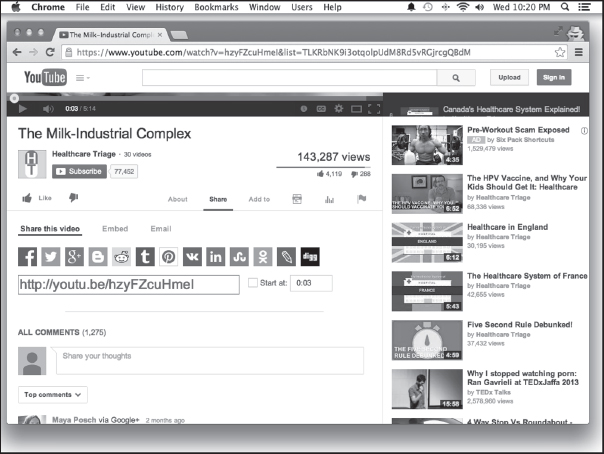
- More: This catch-all button lets you see more information on the video if the channel manager offers it up. This info includes statistics about the video and a transcript. You can also report this video to YouTube if you see something inappropriate in its content. This last piece should be used only sparingly — Chapter 10 covers the details.
- Description: The video description field should provide all sorts of helpful information about the video and a way for viewers to get additional information, which may include links to make a purchase or support your candidate, for example. Only part of the description is shown, so a viewer can click the Show More bar under the description summary to see the rest of the information. Chapter 9 shows you how to best organize the description field.
- Comments: Comments about the video are placed just below the description section. Regular YouTubers know that comments can be highly informative and occasionally pretty bad. Remember that YouTube is a social media platform and with it comes the good, the bad, and the ugly — especially in the Comments section. As a channel manager, you definitely want comments, but keep in mind that you can filter out inappropriate ones or ban specific users who only cause trouble. (We tell you more on comments management in Chapter 10.)
Working with a YouTube Account
There are a number of reasons you'd want to open a YouTube account. Though the logged-out experience is interesting, you need an account to subscribe to channels, create playlists, comment on videos, and generally become part of the YouTube community. Not to mention, you need an account to launch your channel where you will upload videos, run ads on those videos, and generate some revenue.
 Be aware that signing up for a YouTube account means signing up for a Google account. Google owns YouTube, and recently, Google has been busy unifying its products under a single login, allowing you to use one username and password to log in to its complementary services like Gmail, Google Drive, Calendar, and Maps in addition to your new YouTube account. You'll also create an account for Google's almost universally unpopular social network, Google+. This Google+ integration has been a big deal at Google in the past couple of years, and Google+ has slowly infiltrated many of Google's most popular offerings. This has caused some unhappiness among longtime YouTubers, but for the new user, it shouldn't be too much of a burden.
Be aware that signing up for a YouTube account means signing up for a Google account. Google owns YouTube, and recently, Google has been busy unifying its products under a single login, allowing you to use one username and password to log in to its complementary services like Gmail, Google Drive, Calendar, and Maps in addition to your new YouTube account. You'll also create an account for Google's almost universally unpopular social network, Google+. This Google+ integration has been a big deal at Google in the past couple of years, and Google+ has slowly infiltrated many of Google's most popular offerings. This has caused some unhappiness among longtime YouTubers, but for the new user, it shouldn't be too much of a burden.
Getting an account
One of the first things you notice when you arrive on the YouTube home page is the Sign In button in the upper-right corner of the screen. Google and YouTube want you logged in so it can monitor your viewing habits and provide more focused video recommendations and — ultimately — relevant advertising. If you already have a Google account and you want to use that account to house your channel, you can. If you're creating a new channel, it may make sense to create a new Google account to go with it.
 You're going to be using this channel as your business and, as someone once said, “You should never mix business and pleasure.” Though not always 100 percent true — many people have jobs they truly enjoy — this statement definitely applies in this case. If you take all the principles in this book to heart, and have a bit of luck, your channel could become very popular. You'll then be in the unenviable position of running your new online video business in your personal email account, and you'll be stuck with the job of sifting through the guilt-inducing emails from your mother, the advertisement for the big sale at the store where you bought a gift for your ex once (like 12 years ago), and, of course, stuff that might actually be important. Rather than deal with that hassle, just go ahead and start a new account. It's free.
You're going to be using this channel as your business and, as someone once said, “You should never mix business and pleasure.” Though not always 100 percent true — many people have jobs they truly enjoy — this statement definitely applies in this case. If you take all the principles in this book to heart, and have a bit of luck, your channel could become very popular. You'll then be in the unenviable position of running your new online video business in your personal email account, and you'll be stuck with the job of sifting through the guilt-inducing emails from your mother, the advertisement for the big sale at the store where you bought a gift for your ex once (like 12 years ago), and, of course, stuff that might actually be important. Rather than deal with that hassle, just go ahead and start a new account. It's free.
Follow these steps to get a Google account you can use on YouTube:
- Click the blue Sign In button.
Doing so takes you to the Google login screen, shown in Figure 2-6, where you can log in or create a new account.
 Last time we checked, the big blue Sign In button was in the upper-right corner of the screen, but be aware that YouTube, like all other websites, tends to redesign things and move buttons around from time to time.
Last time we checked, the big blue Sign In button was in the upper-right corner of the screen, but be aware that YouTube, like all other websites, tends to redesign things and move buttons around from time to time. If you already have a Google account, you may already be logged in. If you're creating a new account to go with a new channel, it may help to use a private browsing mode in your web browser to avoid confusing Google.
If you already have a Google account, you may already be logged in. If you're creating a new account to go with a new channel, it may help to use a private browsing mode in your web browser to avoid confusing Google. - Click the Create an Account link below the Username and Password fields.
Doing so takes you to the Create Your Google Account page.
- Fill in the necessary information.
The fields shown in Figure 2-7 are much what you'd expect, but here's a description of each item anyway:
- Name: This is the name that will be associated with your account. You can use your real name here, or a made-up name that has something to do with your account. Just be aware that the name will function as the public face of your channel, so sophomoric attempts at humor are probably not the way to go. Note that creating a new account here automatically creates a new (linked) Google+ account.
- Your current address: We like Gmail, so create a new Gmail address when setting a new account rather than using your current email address. It will make all your YouTube work easier. Below this field is a link that offers the option to create a new Gmail account.
- Password: You've probably done the Create a Password and Confirm Your Password song-and-dance a thousand times before, so we won't offer any advice other than to recommend that you follow the sound password tips that Google offers during this process.
- Birthday: No ifs, ands, or buts — you need to choose a birthday. You may not wish to show your real age, what with YouTube largely being a young person's game, but we're also not going to encourage you to lie.
 If you're going to be a smart aleck and decide to give the age of your channel rather than your own age, make the age at least 18. Some content on YouTube has age restrictions, and giving your channel a birthday that makes it less than 18 years old can come back to bite you.
If you're going to be a smart aleck and decide to give the age of your channel rather than your own age, make the age at least 18. Some content on YouTube has age restrictions, and giving your channel a birthday that makes it less than 18 years old can come back to bite you. - Gender: Gender is truly up to you. It's a sensitive subject these days, so we're not going to joke about it here. Personally, when we're creating business accounts, we usually choose Other, because we think of the channels as an inanimate object.
- Mobile phone: A mobile phone number is required for identity confirmation and account recovery processes. (You use account recovery when you've forgotten your password.)
- Prove you're not a robot: Prove that you're a human by typing in the alphanumeric code that's shown in the image. Google does what it can to prevent computer programs (known as robots or ‘bots) from setting up accounts.
- Set your location: Google's terms and conditions for YouTube are dictated by country. When we think of the Internet, we don't necessarily consider borders, but it's especially important for video rights.
- Agree to Google's terms and services agreement: This is the requisite “fine print.” We'll leave it to you and your legal representation to decide whether you're comfortable with it.
- Email: If you've chosen to set up new Gmail email address, you'll be asked to provide an alternative email, also for security and recovery. If you're using your current email, then this field won't appear.
Figure 2-6: The Google login screen.

Figure 2-7: Google wants all your details before you're granted an account.
- Click Next Step.
If Google doesn't recognize your phone number or your current or alternative email address, you'll need to verify your account via text message or a voice call. You're given the choice on a page like the one shown in Figure 2-8. If it does recognize you, it will ask you to set up a Google+ profile. If that's the case, you don't need to verify and you may proceed directly to Step 7.
- Choose your verification method and then click Continue.
Whichever method you choose — Voice Call or Text Message (SMS) — Google manages to get a verification code sent your way.
- In the Enter Verification Code text field, enter the code that was sent to you (see Figure 2-9) and then click Continue.
The next screen requires that you create a Google+ account. This is not optional. Google has had trouble attracting users to its social network, Google+, and this is how it generates user interest — by requiring users of its more popular services to have a Google+ account as well. There's no getting out of it, so don't even try.
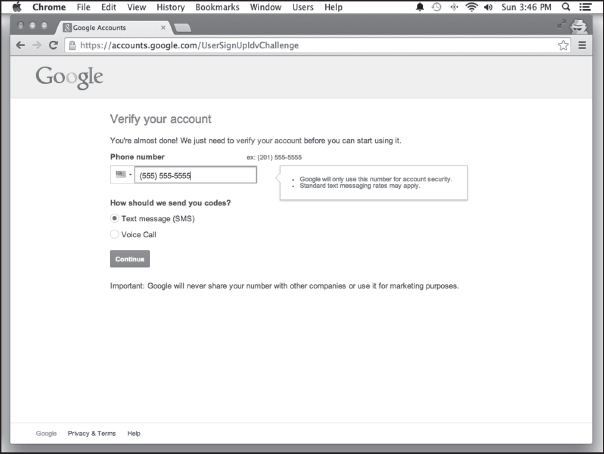
Figure 2-8: Verify your account by text message or phone call.
- Click Next Step to optionally create a public Google+ profile, as shown in Figure 2-10.
Google displays a lovely Welcome screen, addressed to you personally. You can add an account picture by clicking the Add a Photo link. Note that you don't need to create a public profile, but YouTube management is bit easier if you do. Click the Create Your Profile button if you want a Google+ profile; otherwise, click the No Thanks button.
- After admiring Google's warm and human touch (Figure 2-11), click the Back to YouTube button to wend your way back to YouTube.
Logging on to your YouTube account
If you have completed all the steps to set up your YouTube account, including clicking that Back to YouTube button to close out the process, you should be logged in to the YouTube site automatically. If that doesn't happen, the first thing you get to do is log in with the account you created using these steps:
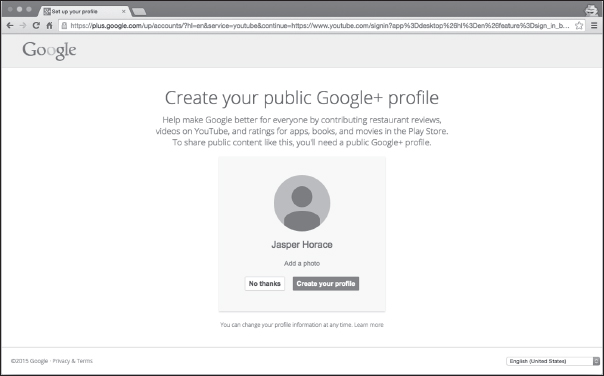
Figure 2-10: Signing up for Google+.

Figure 2-11: Welcome to Google!
- Click the Sign In button at the top of the YouTube main screen.
You're taken once again to the Google Sign In screen (refer to Figure 2-4) and prompted to enter your account details.
- Sign in with the email address and password that you used when creating your account.
You're in! You'll see a blue banner across the top that says “You are now registered with YouTube!”
At this point, you're logged into YouTube, but don't yet have your channel set up. We'll cover that in the next section.
Creating a YouTube Channel
Building a channel is what you came here to do, and now it's time to get to it. You can do the work to establish your channel after you've logged in to YouTube with a Google account. After that's done, follow these steps to get your channel off the ground:
- Log in to YouTube, and click your channel icon in the top right to bring up the Creator Studio and YouTube Settings pull-down menu.
- Click the Gear icon.
 You're taken straight to the Account Settings Overview screen.
You're taken straight to the Account Settings Overview screen.In most Google products, this Gear icon means “settings.”
You should now be looking at a simple overview of your account information, similar to the one shown in Figure 2-12.
- To create your channel, click the Create a channel link next to your email address.
Doing so opens the Use YouTube As dialog box, shown in Figure 2-13, which prompts you to choose a channel name.
- Decide on a channel name.
Your choices are to go with the name associated with your Google+ account for your channel — click the OK button in the Use YouTube As dialog box to do that — or to choose a custom name. Most readers of this book are hoping to make a business of their YouTube channel, so you'll probably want to choose a custom name.
Figure 2-12: Creating a channel.
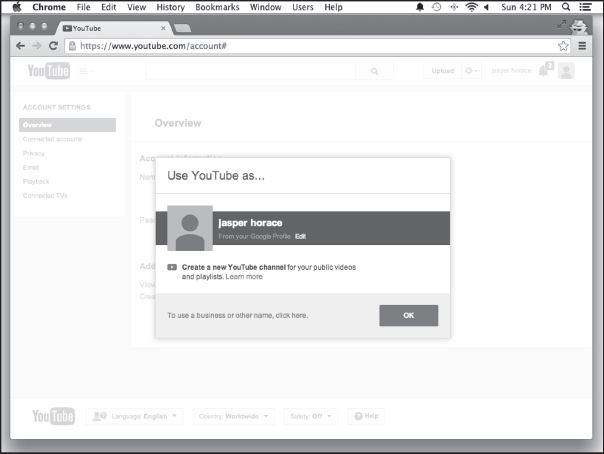
- (Optional) To choose a custom name, click the link labeled To Use a Business or Other Name, Click Here.
Sometimes it's okay to use your real name for your channel. If your content will be personality based (a vlog based around you, for example), this can work just fine. See the nearby sidebar, “Choosing a channel name,” for more insight on picking a good channel name.
- (Optional) Enter your custom channel name into the Create a New Channel dialog box, as shown in Figure 2-14.
- Choose a category for your channel from the drop-down menu below the channel name.
Your (rather limited) choices here are pretty much what you'd expect:
- Product or Brand
- Company, Institution, or Organization
- Arts, Entertainment, or Sports
- Other
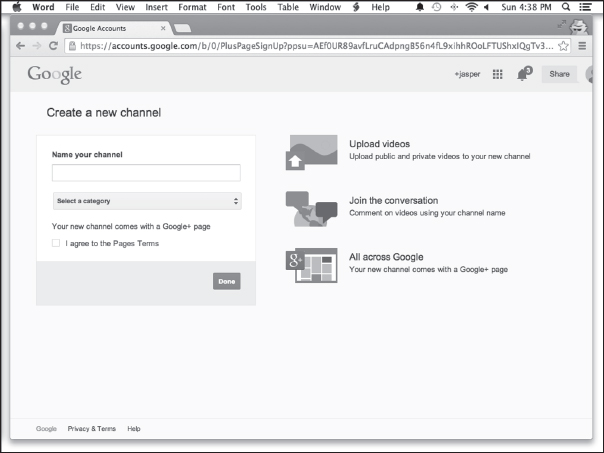
Figure 2-14: Choose your channel name, and make it a good one.
Take a reflective pause before you choose a username or channel name or other identifying criteria you want as your public face for the whole YouTube world. An overhasty decision here could end up being one that you regret later. Many a creator has made the mistake of beginning to upload videos to what they thought would remain a low-key, personal channel, only to have that channel take off in popularity, at which point they begin to feel trapped in a channel named after their cat. (Okay, just to be clear, this wouldn't be a problem if the channel is actually about your cat). The Google+ integration actually makes changing the channel name on the fly pretty easy and painless, even after the fact. The channel URL, however, is a different story, and you'll learn about that later in this chapter.
Keep the following advice in mind when making your reflections:
Don't rush into anything. You should think hard about this decision. Though it seems like a light one, it really can impact the success of your channel in the long run if you choose a bad name.
- Try to relate the name to your content. Are you creating a channel about video games? Try to work a gaming term into your title. If you plan to create fitness-related content, try to integrate workout or sports terms.
- Avoid profanity, vulgarity, and inside jokes. Though you may find it hilarious to name your channel Dadfarts, a name like that will necessarily limit your market. It's hard to predict what path your videos might take on their way out into the world, and a sophomoric name (or a downright obscene one) might deter your viewers from sharing your video. Note: You want people to share your videos!
- Make the name catchy. Your channel name needs to be memorable. People love puns, rhyming, and alliteration, but don't try to integrate all three. That might be a little much.
- Make it easy to spell. People need to be able to find your channel, and choosing a word that's difficult to spell can prevent people from finding you. Do not see this as a felicitous opportunity to create a recondite channel name thronged with abstruse vocabulary that will confuse and confound your potential viewers.
- Make it easy for people to talk about. When you think you've hit on the perfect name, try reading it aloud a few times and make sure you can pronounce it. You want to have a channel name that people can talk about and make themselves understood. The best test for this is to call a friend on the phone and direct her to your channel. If you can tell your friend the channel name and she can get there without your having to spell it, you've got a usable name on your hands.
- Make sure the name is available and that you won't be confused with another business on YouTube or elsewhere. You should search the web in general and YouTube specifically to make sure your brilliant channel name isn't already in use elsewhere. You should also ensure that the URL you prefer is available. YouTube's allocation of URLs is not automatic, and you choose your custom URL in a later step. So, even if your channel name is available, your custom URL may not be available. Check this in advance, or else it can turn into a real problem.
After you've chosen a channel name and a category, YouTube notes that you're also creating another Google+ account, this one in the name of your channel.
 You can assign verticals or genres to each video individually when you upload it. For more about that process, check out Chapter 9.
You can assign verticals or genres to each video individually when you upload it. For more about that process, check out Chapter 9. - Agree to the terms and conditions for Google+ accounts by selecting the check box.
You'll also get a new Google+ page by default. You don't have to do anything with this, but it's a good place to share some of your YouTube and social media activity if you have a following there.
- Click the Done button.
You are now the proud owner of a channel with no content and a boring default layout. (Check out Figure 2-15 to see what we mean.) You'll notice in the upper-right corner that the name has changed from your Google account name to your brand-spanking-new channel name. But all that is covered in Chapter 3. You have even more account setup tasks to complete.
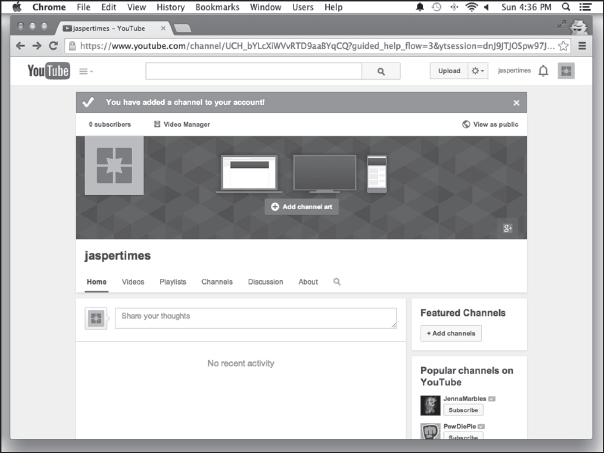
Figure 2-15: The default channel layout, which is boring.
Verifying Your YouTube Channel
Before you get around to beautifying your channel and making it your own, you need to verify your channel to prove that you're a real human being and not some kind of Internet robot who has created this channel for nefarious purposes. Several steps are involved in verifying your account:
- Log in to YouTube and click your channel icon in the top right to bring up the Creator Studio and YouTube Settings pull-down menu.
- Click the Gear icon.
- Doing so takes you to the Account Settings Overview page.
Click the View Additional Features link (refer to Figure 2-12).
A long list of features appears, but you're interested in the Verify feature — you need to verify again before you can move on.
- Click the Verify button.
The Account Verification page appears, spelling out that account verification is a two-step process. The first step of the verification asks for your country location and asks you to specify how you want to receive a verification code, as shown in Figure 2-16.

- Specify your country location, choose a verification method, and then click Next.
You can receive a verification code by text message or voice call. Since you needed a mobile number to sign up for your basic Google account, you'll probably choose Text Message, but if you want the pleasure of listening to an automated phone system, you can opt for the voice call. Just pick an option and click Next, which takes you to Step 2, as shown in Figure 2-17. Whichever delivery method you choose, you'll soon receive a numeric code.
- Enter your verification code and then click Submit.
You move on to a screen with a satisfying check mark that informs you that you're verified.
- Click Continue.
You are now verified! You're returned to the Additional Features page, where this whole verification thing began.
This simple verification unlocks a number of features within your YouTube account, many of which now have green dots next to them on the Additional Features page. We list only a few of the new abilities you've just unlocked for your channel:
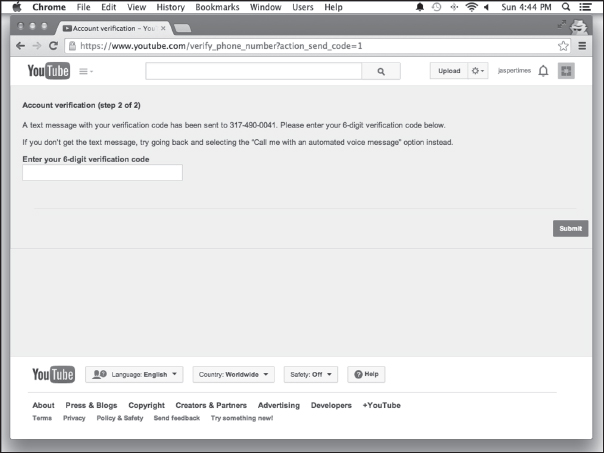
Figure 2-17: Verification, Step 2.
- Longer videos: You can now upload videos more than 15 minutes long.
- External annotations: Links to outside websites can now be placed in your videos. (For more on how to do this, check out Chapter 10.)
- Custom thumbnails: You can now upload custom images to act as the thumbnail for your video. (Chapter 9 also has more on custom thumbnails.)
- Unlisted and private videos: Ever wanted to grant limited access to your videos to a chosen few? Now you can. (More on this neat feature in — you guessed it — Chapter 9.)
Setting Up a Custom Channel URL
By default, YouTube assigns your channel an ugly, random, and completely unmemorable URL. (URL, short for Uniform Resource Locator, is a fancy name for a web address.) You'd do well to replace this ugly URL with one that supports your branding and helps viewers remember your channel. Just note that, to update the URL, your channel must be in good standing. In some cases, YouTube may make you wait for 30 days to create a new channel name. (Not sure what “in good standing” means? Check out Chapter 9.)
Anyway, here's how you get the customizing process started:
- Log in to YouTube and click your channel icon in the top right to bring up the Creator Studio and YouTube Settings pulldown menu.
- Click the Gear icon.
You're taken straight to the Account Settings Overview screen.
- Click the Advanced link located right below your new channel name.
You progress to the advanced channel settings, which you can see in Figure 2-18. In the Channel Settings section, you see the randomly generated URL.
- Under the Channel Settings heading, click the Create Custom URL link.
Doing so takes you to a page that prompts you to choose a new, custom channel URL, as shown in Figure 2-19.
- Choose a custom channel URL.
 You get only one chance at this, so get it right. If you screw it up and choose a channel URL you hate, you need to delete your channel and start over.
You get only one chance at this, so get it right. If you screw it up and choose a channel URL you hate, you need to delete your channel and start over.
Figure 2-18: Advanced settings, featuring the confusing random URL.
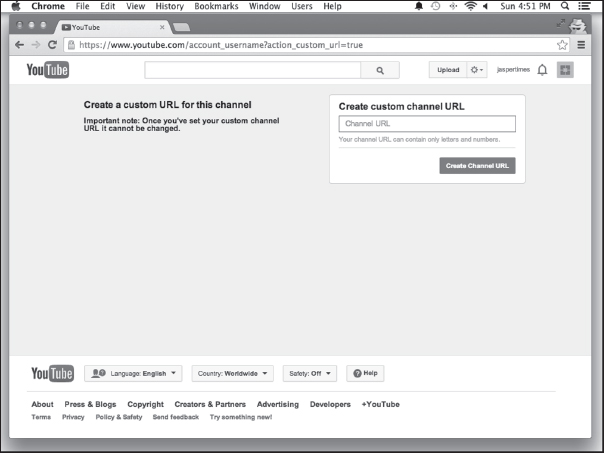
Figure 2-19: Creating a custom URL.
Since you followed the advice earlier in this chapter and checked to make sure your URL was available before you chose your channel name (right? right?), you can just enter the name of your channel and you'll be all set up with a nice, clean URL that matches your channel — something like http://www.youtube.com/user/mychannelname.
Joining the YouTube Partner Program
It's possible to make money on YouTube. If you're really successful, producing content for YouTube could be your full-time, exciting job. But don't run to the bank yet, because you're going to need to create a great channel, fill it with wickedly good content, build a passionate community of fans — and join the YouTube Partner Program.
The YouTube Partner Program is a formalized way of helping content creators (which usually goes hand-in-hand with channel owners because they're often one and the same) make money several ways:
- Advertising: You can allow Google and YouTube to place ads against your content and receive a share of the ad revenue. You learn all the details about this in Chapter 14.
- Subscriptions: You can offer paid subscriptions with viewers paying a monthly or yearly fee for access. This is not for everyone, and you're going to need some unique content. Viewers on YouTube usually don't like to pay.
- Sales: You can use your content to help sell your product and actually provide special links where viewer can go buy your stuff. This is done through a special clickable overlay?, called a Merch annotation. Though there are several types of annotations (see Chapter 10 for all the details), this one is available only to partners.
Though the monetary aspect of the YouTube Partner Program is the primary driver for most creators, YouTube also provides some support for content generation though places like YouTube Spaces, special studios built just for YouTube creators and advertisers around the world. Check it out at https://www.youtube.com/yt/space.
Our recommendation is to not rush into the partner program right away. Focus on your channel, content, and community, which you learn about in detail in this book. With all that in place, you can check out Chapter 14 to get the revenue engine humming.
